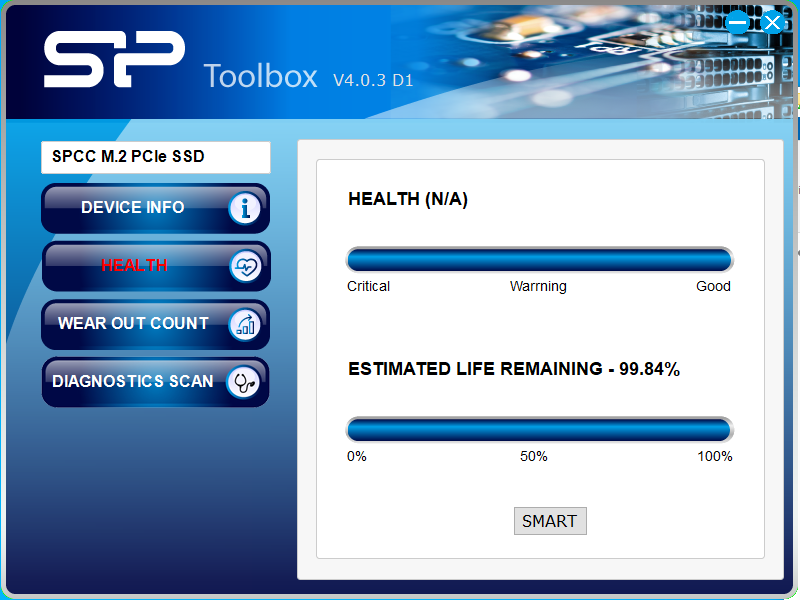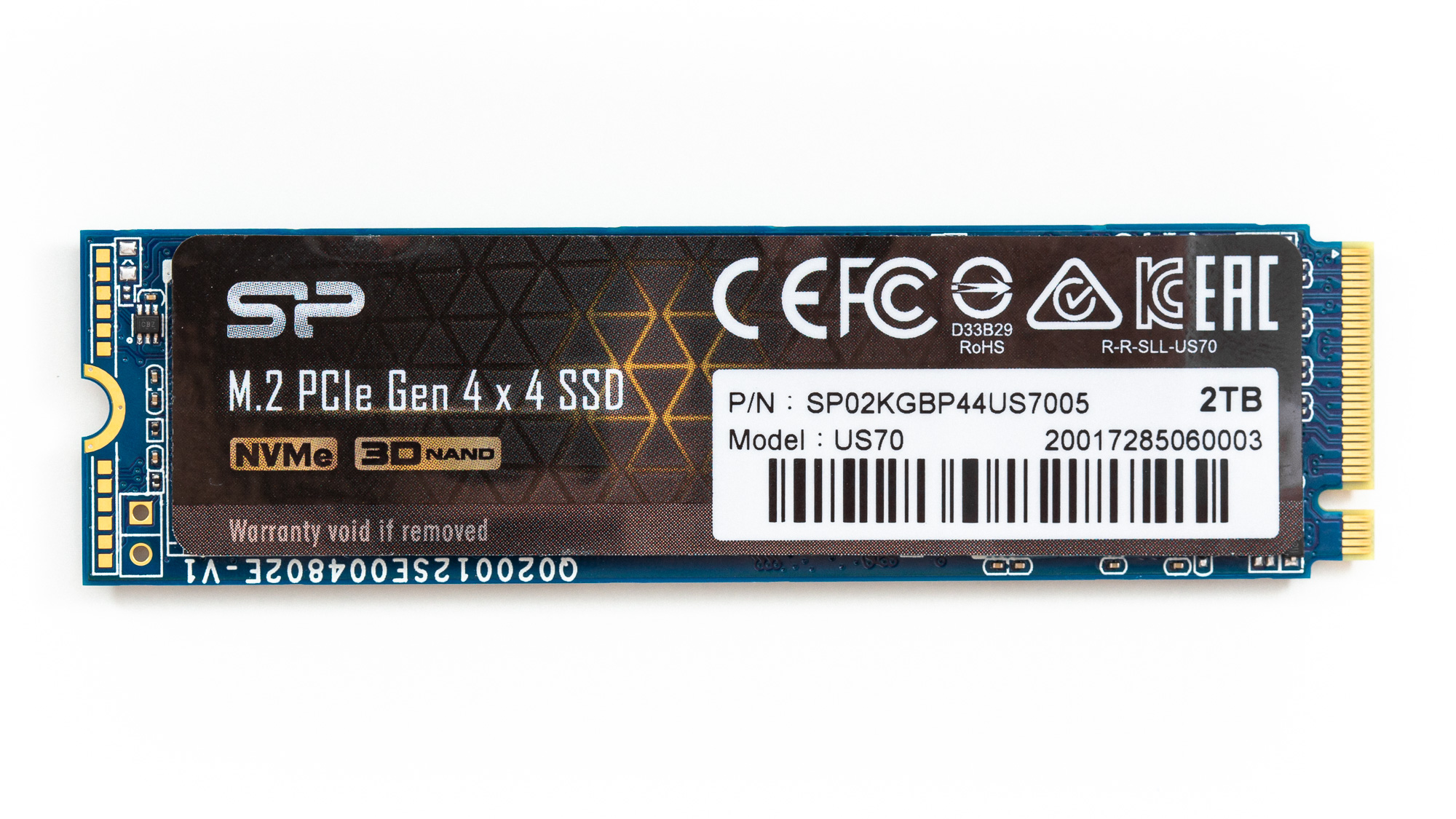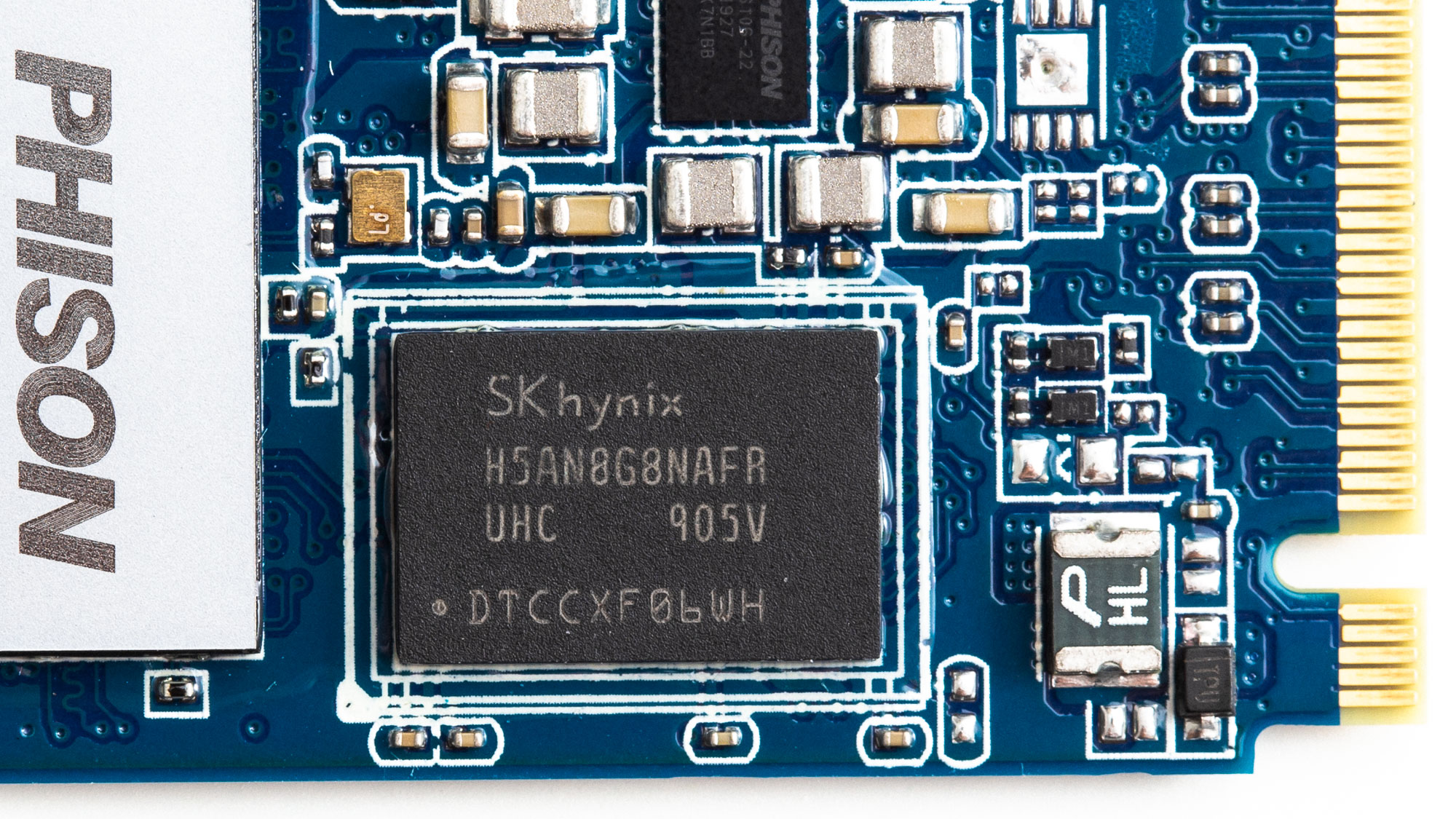Tom's Hardware Verdict
Silicon Power’s US70 is a low-cost PCIe 4.0 X4 NVMe SSD that's a great value pick, but it lacks the looks and features needed to be the best.
Pros
- +
Relatively low-cost
- +
Moderate PCIe Gen4 performance
- +
5-year warranty
Cons
- -
Slow write speed after write cache fills
- -
Blue PCB
- -
No AES 256-bit encryption
- -
Lackluster software support
Why you can trust Tom's Hardware
Silicon Power’s US70 is one of the cheapest PCIe 4.0 SSDs on the market, offering up to 5GBps of throughput for those just looking to speed up their computing experience by upgrading from a slow SATA SSD, or worse, an HDD. Not only is it fast, but it is also rated to endure up to 3.6PB of writes. However, despite all the value it offers, it lacks quite a bit in the looks department.
Silicon Power’s US70 is a generic E16-based SSD with Kioxia’s 96L TLC flash. The company designed the SSD to deliver near-bleeding-edge Gen4 performance, but that was before the release of recent beasts like WD’s Black SN850 and Samsung’s 980 Pro. Still, while not quite as fast as those newer models, it’s much cheaper and comes packing some hefty endurance ratings that place it up there as one of the most enduring consumer SSDs you can buy – its endurance rating is three times higher than both the WD Black SN850 and Samsung 980 Pro.
Specifications
| Product | Silicon Power US70 1TB | Silicon Power US70 2TB |
|---|---|---|
| Pricing | $174.99 | $319.99 |
| Capacity (User / Raw) | 1000GB / 1024GB | 2000GB / 2048GB |
| Form Factor | M.2 2280 | M.2 2280 |
| Interface / Protocol | PCIe 4.0 x4 / NVMe 1.3 | PCIe 4.0 x4 / NVMe 1.3 |
| Controller | Phison E16 | Phison E16 |
| Memory | Kioxia 96L TLC | Kioxia 96L TLC |
| Sequential Read | 5,000 MBps | 5,000 MBps |
| Sequential Write | 4,400 MBps | 4,400 MBps |
| Random Read | 750,000 IOPS | 750,000 IOPS |
| Random Write | 750,000 IOPS | 750,000 IOPS |
| Endurance (TBW) | 1,800 TB | 3,600 TB |
| Part Number | SP01KGBP44US7005 | SP02KGBP44US7005 |
| Warranty | 5-year | 5-year |
The US70 is available in limited capacities of 1TB and 2TB with street prices of $175 and $320, respectively. Silicon Power’s US70 is rated to deliver up to 5/4.4 GBps of sequential read/write throughput and can sustain 750,000 random read/write IOPS.
Unlike some SSDs that leverage static or hybrid cache architectures, Silicon Power’s US70 comes with a large dynamic SLC write cache that spans one-third of the device’s available capacity. Silicon Power’s US70 quickly and predictably flushes its cache to enable consistent performance not only days after your last workload but also within only minutes.
With Phison’s fourth-generation LDPC ECC, the US70 is not only backed by a five-year warranty, but Silicon Power rates the US70 to endure up to three times as many writes as Samsung’s 980 Pro at both capacities. The US70 supports Trim, S.M.A.R.T. data reporting, and has secure erase capability, but it lacks AES 256-bit hardware encryption.
Software and Accessories



Silicon Power supports the US70 with a very basic SSD toolbox that isn't comparable to the sophisticated level of Samsung’s Magician or WD’s SSD Dashboard. Silicon Power’s SSD Toolbox allows you to monitor the device’s health and temperature as well as run some simple diagnostic tests.
A Closer Look



Silicon Power’s US70 comes in an M.2 2280 double-sided form factor at each capacity, meaning there are components on each side of the PCB, preventing it from being used in the most ultra-slim devices that require single-sided SSDs. The US70 is definitely lacking aesthetically with an unappealing sticker over top of the components, and the blue PCB is hard to match with other components.
Get Tom's Hardware's best news and in-depth reviews, straight to your inbox.


Silicon Power’s U70 leverages Phison’s PS5016-E16 PCIe 4.0 x4 NVMe 1.3 SSD controller. This quad-core controller incorporates dual 28nm Cortex R5 CPUs and CoXProcessor 2.0 technology to enable fast and consistent write performance and better efficiency. The controller affords the US70 end-to-end data path protection, Active State Power Management (ASPM), Autonomous Power State Transition (APST), and the L1.2 ultra-low power mode with support for thermal throttling if needed.
Unlike cheaper alternatives like Adata’s XPG Gammix S50 Lite, the controller in the US70 leverages a DRAM buffer for FTL table mapping. There are two SK hynix 8Gb DDR4 DRAM ICs clocked at 1,600 MHz on our 2TB sample, one on each side of the PCB, while the 1TB model should come with half of that.

The US70 has a total of four NAND packages, two on each side of the PCB, with each package containing eight 512Gb dies of Kioxia’s 96L TLC (thirty-two in total). The flash interfaces with the controller at speeds of 800 MTps over eight NAND channels. The flash features a dual-plane architecture for higher interleaving performance.

Sean is a Contributing Editor at Tom’s Hardware US, covering storage hardware.
-
linuxdude I'll never understand why tomshardware thinks a "blue PCB" or "boring looks" are of any importance for an SSD.Reply -
SeanSkiVT Replylinuxdude said:I'll never understand why tomshardware thinks a "blue PCB" or "boring looks" are of any importance for an SSD.
Agreed, I don't understand how this is even remotely relevant. The drive is most likely going to be slammed into a laptop, or placed under a heat spreader on a desktop motherboard. Nobody's ever going to see the thing.
And it's not like it got referenced once, it was referenced several times within the article. -
ajr1775 I find the Pioneer APS SE20G to be a better value. Just built a 5600X/MSI B550 Gaming Carbon WiFi using this NVME.Reply -
Co BIY Title underrates subject compared to the article.Reply
Seems like the testing indicates a new value leader in PCIe 4.0 SSDs. Just below the leaders for much less.
"Penny-pinching" is negative and implies the bad side of being cheap.
Should definitely be moved to the value spot over the Adata. Adata needs to be placed in the review penalty box for the XPG fraud.
Adata damaged their reputation and that of all reviews on Tom's (and elsewhere). -
NP ReplyCo BIY said:Title underrates subject compared to the article.
Seems like the testing indicates a new value leader in PCIe 4.0 SSDs. Just below the leaders for much less.
Even so, this is still not good value. The class "PCIe 4.0 SSDs" is also quite arbitrary. It's a bit similar to a hypothetical class of "PCI 4.0 GPUs" in that it makes no sense as a review object delimiting criterion. Price, capacity and performance are meaningful criteria for identifying value in SSD. Or some technique or feature that creates added capabilities in a qualitative sense, like DLSS2.0 or encryption. Wider bus is not such capability, because it be reduced into the primary criterion of performance, which we are already considering for every equipment.
With these considerations in mind, the value leader in 1TB nor 2TB SSDs this one is clearly not. Current value leaders in 1TB-2TB range would be Intel's 665p and Pioneer APS SE20G.
In those (relatively niche) cases where you REALLY must have the extra performance, you are almost always better off purchasing a Samsung's 980 or similar level SSD, which this one is not. So basically, regardless of what you want, there is a better SSD option available for you. Because of this, it would be more accurate to say that this is not the (value) leader in any meaningful category of SSDs. -
OriginFree Replylinuxdude said:I'll never understand why tomshardware thinks a "blue PCB" or "boring looks" are of any importance for an SSD.
Well Tom's knows that black PCBs make the SSDs faster than the blue ones. ;-) -
mrv_co ReplySeanSkiVT said:Agreed, I don't understand how this is even remotely relevant. The drive is most likely going to be slammed into a laptop, or placed under a heat spreader on a desktop motherboard. Nobody's ever going to see the thing.
And it's not like it got referenced once, it was referenced several times within the article.
ditto, makes zero sense. -
seanwebster Replylinuxdude said:I'll never understand why tomshardware thinks a "blue PCB" or "boring looks" are of any importance for an SSD.SeanSkiVT said:Agreed, I don't understand how this is even remotely relevant. The drive is most likely going to be slammed into a laptop, or placed under a heat spreader on a desktop motherboard. Nobody's ever going to see the thing.
And it's not like it got referenced once, it was referenced several times within the article.
Strange, I don't understand why someone would want an all blue or green PCB when black PCBs are available. Imagine if all the motherboards in the market still had green or blue PCBs - non-blacked out expansion slots, etc. Many motherboards still don't even come with M.2 heatsinks, so unappealing designs and colorful PCBs don't blend into an aesthetics-focused build - something many enthusiasts are sensitive to. Even sub $100 1TB M.2 NVMe SSDs have black PCBs.mrv_co said:ditto, makes zero sense. -
Oshyan What the heck does Tom's have against this drive? Or why the hard-on for the Gammix S50?Reply
I took a few minutes to put together a spreadsheet of where each drive ranks (1-10 of the 10 compared) for all of the quantitative benchmarks (i.e. the ones with a score). The US70 had an average placement (rank) of 2.91, so basically it placed 3rd of 10 tested drives, on average. The S50? 4.95! (higher is obviously better) So at best the S50 is, according to Tom's Hardware's own tests, "middle of the road" (almost precisely), whereas the S70 is "better than average".
Factor pricing into it and the S70 beats the pants off the S50 with both a higher rank and lower price, whether at retail or, even more so, at actual market prices, since the S70 is currently on sale (on Amazon, at least). US70 is $175 retail and $148.00 street right now. S50 is $180 retail or $165 street (Amazon with a $15 coupon). The US70 should be the very clear budget performance pick, and yet... it's not. For reasons that are entirely unclear, except uh maybe the color of the PCB and lack of encryption?
WTF Tom's?
Update: my pricing on the S50 Lite is incorrect above. See my reply below where I address this in context.